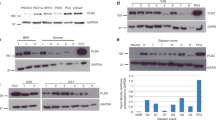Abstract
Glycosylphosphatidylinositol-specific phospholipase D (GPI-PLD) is a highly specific enzyme whose only known substrate is the GPI anchor of cell surface proteins. GPI-PLD measurements, however, are technically difficult since the enzyme is expressed at low levels in cells and tissues, and serum contains large amounts of inactive, latent GPI-PLD interfering with protein-based assays. We have therefore developed a semi-quantitative RT-PCR method to measure mRNA expression of all known GPI-PLD isoforms in cells and tissues. In human ovarian cancer cell lines, GPI-PLD mRNA expression correlated with GPI-PLD enzyme activity and with the shedding of the GPI-anchored tumor and prognostic markers, urokinase receptor and CA125, from the cell surface. This supports a potential role for this enzyme in the generation of circulating prognostic markers in malignant tumors. Similarly, in human epithelial cells of the skin, GPI-PLD mRNA expression increased with tumor progression. Whereas normal keratinocytes did not express significant amounts of GPI-PLD mRNA, expression was dramatically induced by serum in immortalized HaCaT keratinocytes and constitutively high and independent of serum in tumorigenic A431 epidermoid carcinoma cells. In addition, GPI-PLD expression was significantly increased in highly malignant, H-ras-transfected murine bladder carcinoma cells as compared to the low malignant, non-transfected parental cells. The competitive RT-PCR described here represents the first quantitative assay specific for cellular GPI-PLD isoforms, and our in vitro analyses suggest that GPI-PLD expression might be associated with tumor malignancy.
Similar content being viewed by others
References
Ferguson MAJ, Williams AF. Cell-surface anchoring of proteins via glycosylphosphatidylinositol structures.Annu Rev Biochem 1988; 57:285–320.
Low MG.The glycosyl-phosphatidylinositol anchor of membrane proteins.Biochim Biophys Acta1989;988:427–54.
Cross GAM. Glycolipid anchoring of plasma membrane proteins. Annu Rev Cell Biol1990;6:1–39.
Low MG.Degradation of glycosyl-phosphatidylinositol anchors by specific phospholipases. In Turner AJ (ed): Molecular and Cell Biology of Membrane Proteins: Glycolipid Anchors of Cell Surface Proteins.Chichester, UK: Ellis Horwood1990;35–63.
Davitz MA, Hereld D, Shak S et al. A glycan-phosphatidylinositolspecific phospholipase D in human serum.Science1987;238:81–4.
Low MG, Prasad ARS. A phospholipase D specific for the phosphatidylinositol anchor of cell-surface proteins is abundant in plasma. Proc Natl Acad Sci USA1988;85:980–4.
Low MG, Huang K-S. Factors affecting the ability of glycosylphosphatidylinositol-specific phospholipase D to degrade the membrane anchors of cell surface proteins.Biochem J1991;279: 483–93.
Brunner G, Metz CN, Nguyen H et al. An endogenous glycosylphosphatidylinositol-specific phospholipase D releases basic fibroblast growth factor-heparan sulfate proteoglycan complexes from human bone marrow cultures.Blood1994;83:2115–25.
Metz CN, Brunner G, Choi-Muira NH et al. Release of GPI-anchored membrane proteins by a cell-associated GPI-specific phospholipase D.EMBO J1994;13:1741–51.
Wilhelm OG, Wilhelm S, Escott GM et al.Cellular glycosylphosphatidylinositol-specific phospholipase D regulates urokinase receptor shedding and cell surface expression.J Cell Physiol1999;180: 225–35.
Sitrin RG, Todd RF III, Mizukami IF et al. Cytokine-specific regulation of urokinase receptor (CD87) expression by U937 mononuclear phagocytes.Blood1994;84:1268–75.
Mizukami IF, Faulkner NE, Gyetko MR et al.Enzyme-linked immunoabsorbent assay detection of a soluble form of urokinase plasminogen activator receptor in vivo.Blood1995;86:203–11.
Pedersen N, Schmitt M, Rønne E et al. A ligand-free, soluble urokinase receptor is present in the ascitic fluid from patients with ovarian cancer.J Clin Invest1993;92:2160–7.
Pappot H, Høyer-Hansen G, Rønne E et al. Elevated plasma levels of urokinase plasminogen activator receptor in non-small cell lung cancer patients.Eur J Cancer 1997;33:867–72.
Stephens RW, Pedersen AN, Nielsen HJ et al. ELISA determination of soluble urokinase receptor in blood from healthy donors and cancer patients.Clin Chem1997;43:1868–76.
Sier K, Stephens R, Bizik J et al. The level of urokinase-type plasminogen activator receptor is increased in serum of ovarian cancer patients. Cancer Res 1998;58:1843–49.
DeWitte H, Sweep F, Brünner N et al. Complexes between urokinasetype plasminogen activator and its receptor in blood as determined by enzyme-linked immunosorbent assay.Int J Cancer 1998;77:236–42.
Wahlberg K, Høyer-Hansen G, Casslen B. Soluble receptor for urokinase plasminogen activator in both full-length and a cleaved form is present in high concentration in cystic fluid from ovarian cancer. Cancer Res1998;58:3294–98.
Mitchell EP. Role of carcinoembryonic antigen in the management of advanced colorectal cancer.Semin Oncol1998;25:12–20.
Maggino T, Gadducci A. Serum markers as prognostic factors in epithelial ovarian cancer: An overview.Eur J Gynaecol Oncol2000;21: 64–9.
Hoener MC, Brodbeck U. Phosphatidylinositol – glycan-specific phospholipase D is an amphiphilic glycoprotein that in serum is associated with high-density lipoproteins.Eur J Biochem1992;206: 747–57.
Metz CN, Zhang Y, Guo Y et al. Production of the glycosylphosphatidylinositol-specific phospholipase D by the Islets of Langerhans.J Biol Chem1991;266:17733–6.
Xie M, Low MG. Expression and secretion of glycosylphosphatidylinositol-specific phospholipase D by myeloid cell lines.Biochem J1994;297:547–54.
O'Brien KD, Pineda C, Chiu WS et al. Glycosylphosphatidylinositolspecific phospholipase D is expressed by macrophages in human atherosclerosis and colocalizes with oxidation epitopes.Circulation 1999;99:2876–82.
Xie M, Sesko AM, Low MG. Glycosylphosphatidylinositol-specific phospholipase D is localized in keratinocytes.Am J Physiol1993; 265:C1156–68.
Boukamp P, Petrussevska RT, Breitkreuz D et al. Normal keratinization in a spontaneously immortalized aneuploid human keratinocyte cell line.J Cell Biol1988;106:761–71.
Möbus V, Gerharz CD, Press U et al. Morphological, immunohistochemical and biochemical characterization of 6 newly established human ovarian carcinoma cell lines.Int J Cancer1992;52:76–84.
Brunner G, Pohl J, Erkell LJ et al. Induction of urokinase activity and malignant phenotype in bladder carcinoma cells after transfection of the activated H-ras oncogene.J Cancer Res Clin Oncol1989;115: 139–144.
Tsang TC, Fung W-J, Levine J et al. Isolation and expression of two human glycosylphosphatidylinositol phospholipase D (GPI-PLD) cDNAs.FASEB J1992;6:A1922.
Tujioka H, Misumi Y, Takami N et al. Posttranslational modification of glycosylphosphatidylinositol (GPI)-specific phospholipase D and its activity in cleavage of GPI anchors.Biochem Biophys Res Comm 1998;251:737–43.
Schofield JN, Rademacher TW. Structure and expression of the human glycosylphosphatidylinositol phospholipase D1 (GPLD1) gene. Biochim Biophys Acta2000;1494:189–94.
Metz CN, Thomas P, Davitz MA. Immunolocalization of a glycosylphosphatidylinositol-specific phospholipase D in mast cells found in normal tissue and neurofibromatosis lesions.Am J Pathol1992;140: 1275–81.
Author information
Authors and Affiliations
Corresponding author
Rights and permissions
About this article
Cite this article
He, X., Hannocks, MJ., Hampson, I. et al. GPI-specific phospholipase D mRNA expression in tumor cells of different malignancy. Clin Exp Metastasis 19, 291–299 (2002). https://doi.org/10.1023/A:1015545407700
Issue Date:
DOI: https://doi.org/10.1023/A:1015545407700




